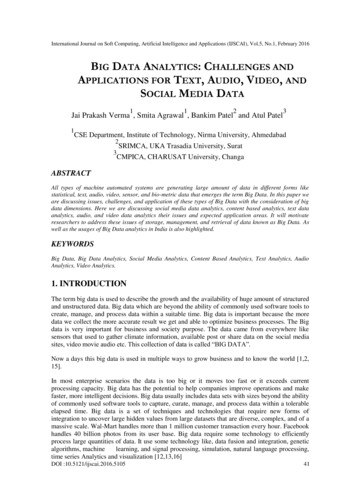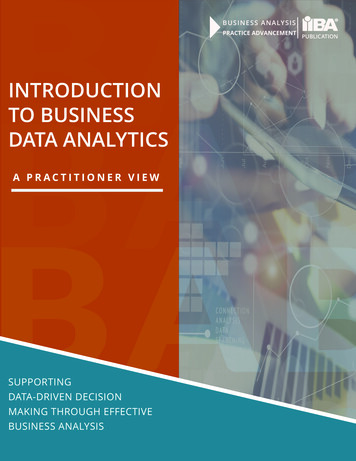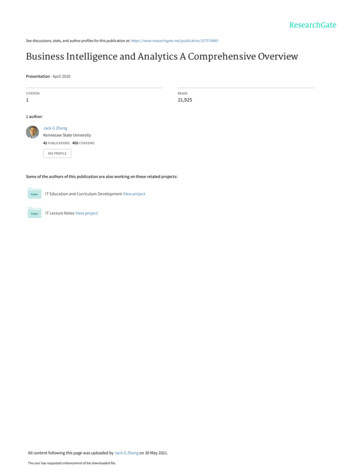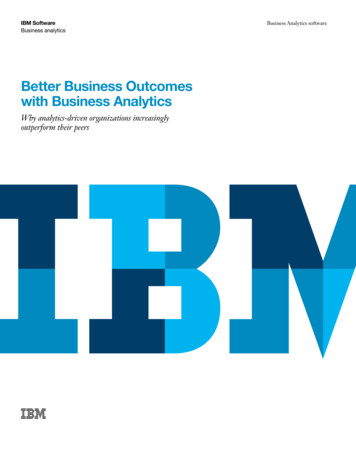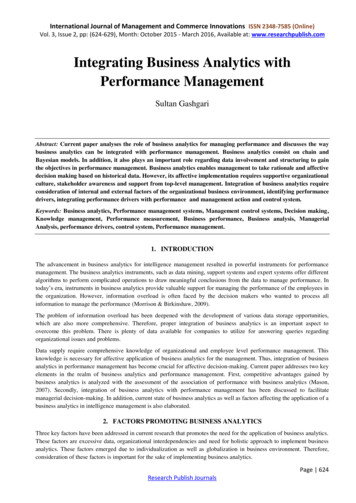
Transcription
International Journal of Management and Commerce Innovations ISSN 2348-7585 (Online)Vol. 3, Issue 2, pp: (624-629), Month: October 2015 - March 2016, Available at: www.researchpublish.comIntegrating Business Analytics withPerformance ManagementSultan GashgariAbstract: Current paper analyses the role of business analytics for managing performance and discusses the waybusiness analytics can be integrated with performance management. Business analytics consist on chain andBayesian models. In addition, it also plays an important role regarding data involvement and structuring to gainthe objectives in performance management. Business analytics enables management to take rationale and affectivedecision making based on historical data. However, its affective implementation requires supportive organizationalculture, stakeholder awareness and support from top-level management. Integration of business analytics requireconsideration of internal and external factors of the organizational business environment, identifying performancedrivers, integrating performance drivers with performance and management action and control system.Keywords: Business analytics, Performance management systems, Management control systems, Decision making,Knowledge management, Performance measurement, Business performance, Business analysis, ManagerialAnalysis, performance drivers, control system, Performance management.1. INTRODUCTIONThe advancement in business analytics for intelligence management resulted in powerful instruments for performancemanagement. The business analytics instruments, such as data mining, support systems and expert systems offer differentalgorithms to perform complicated operations to draw meaningful conclusions from the data to manage performance. Intoday’s era, instruments in business analytics provide valuable support for managing the performance of the employees inthe organization. However, information overload is often faced by the decision makers who wanted to process allinformation to manage the performance (Morrison & Birkinshaw, 2009).The problem of information overload has been deepened with the development of various data storage opportunities,which are also more comprehensive. Therefore, proper integration of business analytics is an important aspect toovercome this problem. There is plenty of data available for companies to utilize for answering queries regardingorganizational issues and problems.Data supply require comprehensive knowledge of organizational and employee level performance management. Thisknowledge is necessary for affective application of business analytics for the management. Thus, integration of businessanalytics in performance management has become crucial for affective decision-making. Current paper addresses two keyelements in the realm of business analytics and performance management. First, competitive advantages gained bybusiness analytics is analyzed with the assessment of the association of performance with business analytics (Mason,2007). Secondly, integration of business analytics with performance management has been discussed to facilitatemanagerial decision-making. In addition, current state of business analytics as well as factors affecting the application of abusiness analytics in intelligence management is also elaborated.2. FACTORS PROMOTING BUSINESS ANALYTICSThree key factors have been addressed in current research that promotes the need for the application of business analytics.These factors are excessive data, organizational interdependencies and need for holistic approach to implement businessanalytics. These factors emerged due to individualization as well as globalization in business environment. Therefore,consideration of these factors is important for the sake of implementing business analytics.Page 624Research Publish Journals
International Journal of Management and Commerce Innovations ISSN 2348-7585 (Online)Vol. 3, Issue 2, pp: (222-222), Month: October 2015 - March 2016, Available at: www.researchpublish.comExcessive data:Excessive amount of data give rise to the problem of data overload. Management often has limited data processingcapabilities. Numerous factors in internal and external environment of the organization need to be analyzed for affectivedecision-making. Therefore, this problem intensified and need for business analytics to filter relevant information andintegrating with performance management is necessary for decision makers to identify key performance indicators andsuccess factors.Adequate amount of data is necessary to make viable conclusions about the problem or issue under investigation, howeverexcessive amount of data create discrepancies that need to be eliminated through filtering data and retaining only relevantinformation (Neely, 1999). Business analytics perform that task, retain value bale data, and discard irrelevant. Therefore,affective decision-making is possible with the use of business analytics. Proper management of dat and its implementationis possible. Although, adequate amount of data is quiet needed, it is worth necessary to manage excessive flow ofinformation. Where, inadequacy is a problem, excessive amount of data is also unnecessary for decision making. Balanceapproach is necessary to take affective decision making in the organization.Organizational interdependencies:Complex organizational environment and interconnection between various practices in organization require holisticapproach to identify performance. Lack of holistic approach makes performance data worthless until it is translated in tomeaningful way. Therefore, holistic approach of data analysis through business analytics contribute for more objectivedecision-making for performance creation through linking performance affects with business analytics. Organization doesnot operate in isolation.Its process and operations are interrelated with each other. Therefore, it is necessary to adopt holistic approach to collectrelevant data that is need to be evaluated simultaneously (Smith & Goddard, 2002). Making decisions based on a certainfactor do not provide complete picture of the issue. Therefore, it is necessary that all interdependencies of an organizationshould be evacuated.This is essentially done through business analytics. Business analytics provides holistic approach to consider allorganizational interdependencies and provides rationale and affective decision-making. Often, issues arise frominadequate picture of the situation going to be confronting by the management. This is the responsibility of the individualsengaged in decision making to consider all facets of decision-making. Organizational interdependencies form integratedview of operations and processes that requires ken observation of integrated elements of performance in organizationalprocesses and operations. Therefore, such integrative view of organizational processes and operations should also bereflected in business analytics.Need for holistic approach to implement business analytics:Although business analytics are applied for business intelligence in the organizations, they are often applied in partsmajorly in planning process. Therefore, one of the reasons behind failure of strategic management decision making isproblems during implementation phase. Current research also lacks in providing meaningful clue for implementingbusiness analytics. Therefore, holistic approach to implement business analytics enables managers to understandinterdependencies among inputs, processes, out puts as well as outcome in performance management (Malmi, 2009).Decision based on targeting specific aspect of organization provides inadequate information for decision-making.For instance, is employee performance is declining, it is necessary to focus on both individual and organizational levelfactors. Ignoring any of the factors could lead to the ineffective evaluation of data for making decisions. Therefore, it isquiet necessary to focus on holistic approach to implement business analytics in the organization.3. INTEGRATING BUSINESS ANALYTICS WITH PERFORMANCE MANAGEMENTA performance management system incorporates multiple layers in managing performance that are inputs, processing, outputs and outcomes. Business analytics are applied with the consideration of these layers. There is absence of approach thatprovides incorporation of all elements in a comprehensive manner. Therefore, presence of such approach could helpmanagers to identify which type of analytics should be used in performance management. Such approach is helpful inimproved decision-making process to sustain the effectiveness and efficiency of performance management. Managementuses multilayer approach in which it has to keep an eye on input, outputs, processes and numerous outcomes to makefurther decisions. These layers include Internal and external factors, identifying performance drivers, integratingperformance drivers with performance and management action and control system. These factors are discussed as under.Page 625Research Publish Journals
International Journal of Management and Commerce Innovations ISSN 2348-7585 (Online)Vol. 3, Issue 2, pp: (222-222), Month: October 2015 - March 2016, Available at: www.researchpublish.comI. Internal and external factors:Internal and external factors are present in the business environment of the organization. These factors are incorporatedwhile applying business model. Therefore, data about these factors is an integral part of business analytics. Such data isnecessary for acquiring relevant and useful information about drawing meaningful conclusion to take decision about theorganizational environment though business analytics. Organizational environment is always dynamic and complex andbusiness analytics play an important role of processing data about internal and external environment. Environmentalscanning provides sufficient data about different external and internal elements such as political changes, competitors andcompetitions. When such data is collected business, analytics process that data into useable information.This information can be used to draw meaningful conclusions about the decision needed by the company. Therefore,business analytics is integral for utilizing internal and external factors in the environment. Environmental scanning set thebasis for setting strategic objectives for the organizational and that ultimately leads towards competitive advantage for theorganization. Such processing of information is not possible without the use of business analytics. Therefore, businessanalytic integration is crucial for environmental scanning to identify internal and external factors and related information.II. Identifying performance drivers:Performance drivers hold key position in performance management. Performance drivers enable employees and theorganizations to meet expected level of performance. Business analytics process important data on inputs, processing,outputs and outcomes. Such processing results in identification of important performance drivers. Performance driverscould be identified from already implemented performance management system or bench marks. These performancestandards could be tangible or intangible. Benchmarks are also available, how firm can develop their own benchmark forthe sake of performance management. Business analytics analyses the processes, operations and job descriptions andspecification of the employees to evaluate performance standards.Therefore, business analytics is essential for integrating performance management and developing performance standardsthat are essential to evaluate performance. Evaluation of organizational processes and operations as well as job descriptionand specification is key element in setting up performance drivers. Therefore, business analytics is important to setperformance drivers that are evaluated on each review period by the immediate supervisor or the manager.III. Integrating performance drivers with performance:After the identification of performance drivers through business analytics, it is necessary to link them with actualperformance. Business analytics analyses such linkage through cause and effect relationship. It is important to considertime lags while depicting such connections. Business analytics could verify such cause and effect relationship in essentialand adequate manner. Once, the connection is established, it is possible to verify the performance on specific performanceindicator. After the identification of performance drivers, it is important to make a link with performance as well. Untiland unless, the link is not created, performance cannot be measured. Business analytics play that role and provideinformation regarding cause and effect relationship through utilization of raw data and converting it to useableinformation.Business analytics make sure that performance drivers actually measure performance and they are valid to evaluatewhether performance is being measured accurately or not. Business analytics take performance data and performancedrivers that evaluate under the actual performance of the employees. Another drawback of lack of integration is exertionof efforts in wrong direction. Although employees perform up to performance drivers, however they are less integratedwith performance outcome, and in result, performance measure goes futile.IV. Management action and control system:Management action and control system is important to manage the performance. Once the cause and effect relationshipbetween performance drivers and actual performance is established, management control verifies whether actualperformance standards are being met or not. Business analytics indentifies the management action and control forperformance measurement. Design for management control and action can be derived from the cause and effectrelationship of the management. Feedback loop is an important factor that can be used to revise and regulate performancedrivers. Mere implementation of performance drivers is not sufficient.Page 626Research Publish Journals
International Journal of Management and Commerce Innovations ISSN 2348-7585 (Online)Vol. 3, Issue 2, pp: (222-222), Month: October 2015 - March 2016, Available at: www.researchpublish.comEvaluation of management control and action plan is important to make sure that performance is going in right direction.In case of lack of performance, action plan and evaluation form the management is necessary to bring the performance onthe right track. Business analytics evaluates which method is useful for evaluating performance and what sort of actionplan is required to monitor, evaluate and to take corrective actions to bring the performance on the right track. Evaluationof performance reviews, review meetings and employee and supervisions meetings could be evaluate din this regard.Therefore, it is also an important part in performance management, which needed to be integrated with business analytics.Business analytics, value addition and implementation problems:Business analytics provide value addition for the organization through utilization of sophisticated and agile methods ofstatistics, mathematics and economics. Business analytics can work on traditional and more sophisticated methods thatinclude financial statements and performance drivers. Accounting data from balance sheet, income statement and profitand loss statements could be essentially utilized by business analytics.On contrary, performance drivers, critical success factors as well performance indicators are essential and adequate part ofbusiness analytics (Emblemsvåg, 2005). These sources are also utilized by business analytics that provide authentic andaccurate information to take performance decisions. Business analytics pave the way for more quantifiable use ofanalytics for the relationship between inputs, processe4s, outputs and outcomes.Therefore, the affective usage of business analytics can be identified with integration of three crucial elements that includeanalytical methods, accounting based applications as well as IT based applications. Some of the IT based applicationincludes data mining. In addition, other prominent elements are target-costing, mapping, cost driven analysis and otherprocessing. Moreover, additional operations involve regression and balanced scoreboard to have a fine decision makingprocess. (Vera-Baquero, 2015).Business integrates with these practices and offer different analytical methods such as envelopment processing in differentoperations. Other officering are auto regression and different chain based models, designed for specific tasks in anorganizations. These models are used to make the business process effective and efficient. Statistical analysis isaggressively used in business analytics. Different statistical and analytical tools are used in business analytics. Therefore,affective usage of business analytics is achieved through integration of these three activities. Working in isolation withoutany integration with management accounting application and IT based application do not provide desired results.Management accounting applications provide important and relevant dat about financial and non-financial performance ofthe origination.IT based application provide necessary tools to extract the data business analytics analyses this data to draw meaningfulconclusions that needed to be implemented in the realm of performance management. There is certain issue that hindersthe effectiveness of business analytics thus affecting its value creation capability. Therefore, there is need to address theseissues as well. Comprehensive amount of data is needed to implement effectively the business analytics in theorganization for performance management.Therefore, large number of organization collects lot of excessive data for decision-making. This problem occurs whenorganization’s management believe that they can measure only those aspects in performance management that are able tomeasure. In fact, measuring performance itself is not a driver. The performance measurement contributes in achievementof competitive advantage. Therefore, key concern is to understand performance data and transforming in to useableinformation that can be utilized to make decisions in performance management. The problem of causal linkage betweenperformance drivers and actual performance can be best identified through business analytics. Hence, there is always needto exploit such benefits and improve areas of deficiencies for the sake of affective decision-making.4. CHALLENGES AND ADVANTAGES OF BUSINESS ANALYTICSManagers often face critical challenges to achieve competitive advantage. Affective use of business analytics improvesstrategic decision making for managers and the can manage performance to achieve competitive advantage. Businessanalytics facilitate understanding of business dynamics for business managers. It is helpful in identifying shifts in businesstrends and changes in internal and external environment. This is important to test strategic decision-making. Provenassumption and identification of environmental factors though business analytics allow managers to implementperformance management that is aligned strategic direction of the company (Schläfke, 2013).Page 627Research Publish Journals
International Journal of Management and Commerce Innovations ISSN 2348-7585 (Online)Vol. 3, Issue 2, pp: (222-222), Month: October 2015 - March 2016, Available at: www.researchpublish.comTherefore, they are in position to identify whether strategic decisions taken are producing desired performance or not.They are in position to alter the strategy or make minor changes in existing strategy to bring back perform at desired level.Operational efficiency can be improved by the business analytics. Business analytics identifies the more efficient ways ofprocessing and operations in terms of cost and time. Therefore, risk of time schedule and resource required can beeliminated affectively. Moreover, business analytics make it possible to learn market and customer behavior. Customer,market and transactional data provide important insight regarding the business trends.Forecasting of sales, demands and seasonal peaks can be identified through trend analysis. Management takes rightdecisions at the right time. This is done through affective business analytics. In addition, management also learns aboutthe mistakes in analysis and prevention measures in future. Business analytics incorporate formal and objective decisionmaking in performance management (Klatt, 2011). Objective decision-making provides more realistic and authenticdecision making to respond to the performance objectives. Besides, above-mentioned advantages associated with businessanalytics, there are constraints that hinder its affective implementation. Another important advantage associated withobjective decision-making is authenticity. Objective decision making authentically addresses the performance level and itsimplementation in the organization.For instance, organizational culture plays an important role in affective implementation of business analytics. Without thesupport of top-level management, organizational culture acceptance as well as acceptance from stakeholder, it is notpossible to reap the benefits of business analytics in adequate and essential manner. Stakeholder need to accept thatdecision-making is done through historical data (Bose, 2009). Role of top-level management is particularly important.Top-level management is involved in decision making in the organization. These are the policies and frameworkestablished by the top-level management that implements strategies. Therefore, if top level is committed in theorganization, the implementation of the business analytics will be affective.Decision making based on historical data always pose threats, because, actual scenario could be different because ofchange in the business environment. Moreover, this is the responsibility of the organization to provide opportunity to itsemployees that they develop sense of business analytics within themselves. New skills in IT and management accountantas well as business analytics is necessary to improve information development for decision making.5. CONCLUSIONImportance of business analytics is realized by both practitioners and scholars. It is discussed that business analytics isassociated with affective decision making and better performance management. Proper integration of performancemanagement with business analytics provides basis for affective and rational decision making for the management. This isan important aspect to achieve competitive advantage. Lower perfuming firms can achieve advantage from such analytics.Therefore, recommendation for integrating business analytics with performance management, make managers understandabout value addition for analytical toolbox. Role of IT applications, business analytics and management accountingapplications and their integration is important for the business performance. The major concern regarding failure orinadequacy of business analytics is lack of such integration. Majority of the firms face such dilemma and they regardperformance management as performance indicator. There is immense need to understand the way business data can beprocessed into information to draw meaningful conclusions.Only then, benefits of business analytics could be reaped. Besides, it is necessary that proper environment should bepresent in the organization that supports implementation of business analytics. Organizational culture, acceptance ofstakeholders as well as role of top-level management is crucial. If organizational culture is not supportive and it does notprovide support for business analytics, it cannot be implemented with complete integration. Moreover, stakeholdersshould aware about the implementation of decision making in the organization that is backed by business analytics.Employees need adequate autonomy to implement business analytics within their day-to-day tasks and activities. Topmanagement provides support in this regard. If top management is not committed to implement business analytics, itsintegration with performance management, employees will also discouraged and business analytics will not bimplemented in the way it is requisite for achieving competitive advantage. Therefore, careful consideration is required toexploit the benefits associated with business analytics and addressing hindrances associated with its implementation.Page 628Research Publish Journals
International Journal of Management and Commerce Innovations ISSN 2348-7585 (Online)Vol. 3, Issue 2, pp: (624-629), Month: October 2015 - March 2016, Available at: www.researchpublish.comREFERENCES[1] Bose, R. (2009). Advanced analytics: opportunities and challenges. Industrial Management & Data Systems, 109 (2),155 - 172.[2] Emblemsvåg, J. (2005). Business analytics: getting behind the numbers. International Journal of Productivity andPerformance Management, 54(1), 47 - 58.[3] Klatt, T. (2011). Integrating business analytics into strategic planning for better performance. Journal of BusinessStrategy, 32(6), 30 - 39.[4] Malmi, T. (2009). In Search of Management Accounting Theory. European Accounting Review, 18(3), 597-620.[5] Mason, R. B. (2007). The external environment's effect on management and strategy: A complexity theory approach.Management Decision, 45(1), 10 - 28.[6] Morrison, A., & Birkinshaw, J. (2009). International Attention and Multinational Enterprise Performance. Journal ofInternational Business Studies, 40(1), 108-131.[7] Neely, A. (1999). The performance measurement revolution: why now and what next? International Journal ofOperations & Production Management, 19(2), 205 - 228.[8] Schläfke, M. (2013). A framework for business analytics in performance management. International Journal ofProductivity and Performance Management, 62(1), 110 - 122.[9] Smith, P. C., & Goddard, M. (2002). Performance management and Operational Research: a marriage made inheaven? Journal of the Operational Research Society, 247-255.[10] Vera-Baquero, A. (2015). Leveraging big-data for business process analytics. The Learning Organization, 22(4), 215- 228.Page 629Research Publish Journals
the sake of performance management. Business analytics analyses the processes, operations and job descriptions and specification of the employees to evaluate performance standards. Therefore, business analytics is essential for integrating performance management and developing performance standards that are essential to evaluate performance.


